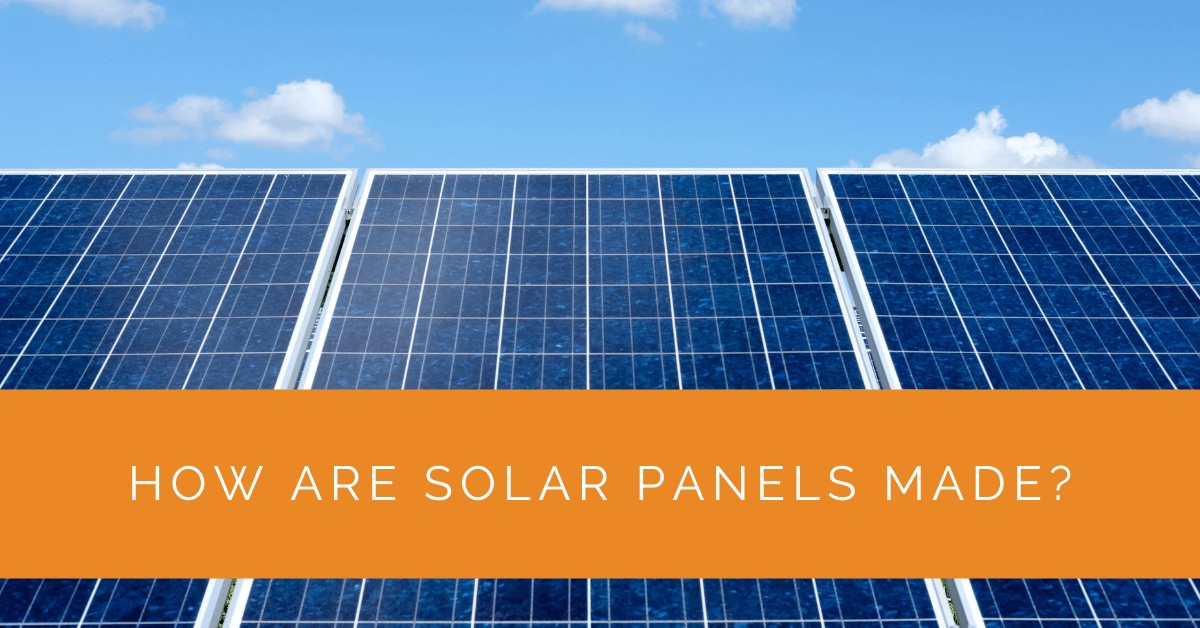Solar panels have become a prominent player in the world of renewable energy, harnessing the power of the sun to generate clean electricity. In this article, we will delve into the intricate process of making solar panels, shedding light on the fascinating journey from silicon production to photovoltaic cells and, finally, the assembly of solar panels.
Contents
- 1 Key Takeaways
- 2 Understanding Photovoltaic Cells
- 3 Silicon Production for Solar Panels
- 4 Creating Photovoltaic Cells
- 5 Assembling Solar Panels
- 6 Types of Solar Panels
- 7 The Role of Solar Panel Installers
- 8 How Solar Panels Work: From Sunlight to Electricity
- 9 Expert Insights From Our Solar Panel Installers About How Solar Panels Are Made
- 10 Experience Solar Excellence with Us!
- 11 Conclusion
- 12 FAQ
Key Takeaways
- Solar panels are made using photovoltaic cells, primarily composed of silicon, which convert sunlight into electricity through the photovoltaic effect.
- The production process involves extracting high-purity silicon (polysilicon) from raw materials, creating crystalline ingots, and forming silicon wafers through precise cutting and doping techniques.
- Different types of solar panels, such as monocrystalline, polycrystalline, and thin-film, offer varying levels of efficiency, costs, and applications, empowering consumers to choose the best fit for their energy needs.
Understanding Photovoltaic Cells
At the core of solar panels lies the fascinating and intricate world of photovoltaic cells. These remarkable cells are pivotal in transforming sunlight into usable electricity, providing an eco-friendly and sustainable energy source. To grasp the marvels of solar panel technology, it’s crucial to delve deeper into the functioning and structure of photovoltaic cells.
Photovoltaic or solar cells are semiconductor devices designed to absorb photons from sunlight. When photons strike the surface of these cells, they transfer their energy to electrons, generating an electric current. Silicon, a widely abundant and highly efficient semiconductor material, is the primary component utilized in most solar panels.
Silicon Production for Solar Panels
Before solar panel creation begins, producing high-purity silicon, known as polysilicon, is an essential step. Silicon, extracted from raw materials like sand, undergoes a meticulous purification process to eliminate impurities and reach the necessary level of purity required for solar panel production.
The process involves crushing the raw materials to obtain silicon dioxide, which is then chemically treated to transform into trichlorosilane gas. This gas is further refined and subjected to the Siemens process, where it is heated in a reactor with hydrogen to produce polysilicon. The resulting polysilicon, in the form of cylindrical ingots, serves as the foundation for creating solar cells.
Creating Photovoltaic Cells
The transformation of polysilicon ingots into functional photovoltaic cells is an intricate procedure that involves multiple precision steps. The Czochralski process, a crystal growth method, enables the production of large single-crystal silicon ingots. These ingots are then sliced into ultra-thin wafers using high-precision cutting techniques, typically resulting in just a few hundred micrometers thick wafers.
A crucial process called “doping” is implemented to enhance the efficiency of photovoltaic cells. Specific impurities, such as boron or phosphorus, are introduced into the silicon wafers during this process. These impurities create regions of positive (p-type) and negative (n-type) charge carriers within the silicon, establishing a p-n junction, which is essential for the separation and flow of charge carriers when sunlight is absorbed.

Assembling Solar Panels
The assembly of photovoltaic cells into fully functional solar panels is a meticulous process that requires precision and expertise. Solar panel manufacturers carefully arrange the individual solar cells in a specific configuration to achieve the desired voltage and current output. The cells are interconnected using solder or conductive adhesives, creating series and parallel connections to optimize the panel’s overall performance.
Once the cells are connected, they are embedded in an encapsulation material to protect them from external elements. A durable and weather-resistant backsheet is added to the rear of the cells. At the same time, a high-transparency, anti-reflective coating is applied to the front surface to enhance light absorption. The encapsulation process ensures the longevity and reliability of the solar panels, allowing them to withstand varying weather conditions over their operational lifespan.
Types of Solar Panels
When it comes to solar panels, one size does not fit all. Various types of solar panels are available in the market, each with distinct characteristics and advantages, catering to different energy needs and preferences.
- Monocrystalline Solar Panels: Monocrystalline panels are renowned for their high efficiency and uniform appearance. They are crafted from a single crystal structure, enabling them to convert sunlight into electricity instantly. Their sleek and black appearance makes them popular for residential and commercial installations seeking a blend of aesthetics and performance.
- Polycrystalline Solar Panels: Polycrystalline panels are manufactured from multiple crystal structures, giving them a distinctive blue color. While they are slightly less efficient than monocrystalline panels, they are cost-effective for those seeking a balance between performance and budget.
- Thin-Film Solar Panels: Thin-film solar panels utilize a different manufacturing process, depositing thin layers of semiconductor material onto a substrate. This results in flexible and lightweight panels that can be used in various applications, including solar tiles and building-integrated photovoltaics (BIPV). While thin-film panels may have lower efficiency than crystalline silicon panels, they offer advantages in certain installation scenarios.
Understanding the different types of solar panels empowers consumers to make informed decisions based on their specific energy requirements and preferences.
![]()
The Role of Solar Panel Installers
While the process of creating solar panels is fascinating, their successful installation is equally crucial. Solar panel installers, also known as solar PV installers, are pivotal in bringing solar energy systems to life. Their expertise ensures that solar panels are optimally positioned to harness the maximum sunlight and efficiently generate electricity.
The installation process begins with a comprehensive site assessment. Installers carefully evaluate the location, orientation, and shading potential to determine the best placement for the solar panels. This assessment helps optimize the system’s performance and ensures its compatibility with the building’s structure and electrical infrastructure.
Once the ideal location is determined, solar panel installers mount the panels securely on rooftops or ground-mounted structures. They handle the electrical connections, ensuring that the solar panels are properly wired and linked to inverters, which convert the DC electricity produced by the panels into usable AC electricity for homes and businesses.
How Solar Panels Work: From Sunlight to Electricity
With a profound understanding of the solar panel manufacturing process and installation, it’s time to explore how solar panels harness the sun’s energy and convert it into usable electricity for our daily needs.
When sunlight reaches the surface of a solar panel, the photovoltaic cells absorb the photons present in sunlight. The energy from these photons excites the electrons within the cells, causing them to break free from their atoms. The electric field created by the p-n junction within the solar cells ensures that the separated electrons flow in one direction, creating a direct current (DC) of electricity.
The DC electricity generated by the solar panels is then directed to an inverter. The inverter is crucial in converting DC electricity into alternating current (AC), the standard form used in homes and businesses. Once converted to AC, the electricity is ready for immediate consumption or can be fed back into the electrical grid, allowing homeowners and businesses to earn credits for the excess energy they produce.
Expert Insights From Our Solar Panel Installers About How Solar Panels Are Made
Understanding the meticulous process of silicon purification and wafer creation reveals just how advanced and precise solar panel manufacturing is. This attention to detail ensures the efficiency and longevity of every panel we install.
Senior Solar Installer
Knowing the journey from raw silicon to the final photovoltaic cell gives us a deeper appreciation for the technology we work with daily. It’s incredible to see how these components come together to harness the sun’s power.
Lead Solar Technician
Seeing the assembly process firsthand highlights the importance of quality control at each step. Proper encapsulation and careful handling during assembly are crucial for the performance and durability of solar panels.
Solar Project Manager
Experience Solar Excellence with Us!
Trust in Solar Panels Network USA, where our seasoned experts deliver top-quality solar solutions for homes and businesses nationwide. With a legacy of countless successful installations and a commitment to sustainable energy, we’re your reliable partner in the solar journey. Ready for a brighter, eco-friendly future? Call us now at (855) 427-0058 and harness the power of the sun!
Conclusion
As we delve into how solar panels are made and work, it becomes clear that solar energy is a remarkable and sustainable solution for our energy needs. From producing high-purity silicon to assembling photovoltaic cells, the journey to harnessing the sun’s energy is an impressive feat of engineering.
Embracing solar power offers us a clean and renewable energy source and an opportunity to reduce our carbon footprint and contribute to a greener planet. With advancements in solar technology and the dedication of solar panel installers, we are witnessing a brighter and more sustainable future powered by the sun’s rays.
FAQ
What is the raw material of solar panels?
The primary raw material used in solar panels is silicon. Silicon is derived from sand, abundantly available in the Earth’s crust. The silicon is purified to become high-purity polysilicon, the foundation for creating photovoltaic cells.
How are solar panels made step by step?
The manufacturing process of solar panels involves several intricate steps:
- Silicon Production: Silicon is extracted from raw materials like sand and processed to obtain high-purity polysilicon.
- Creating Photovoltaic Cells: The polysilicon is transformed into cylindrical ingots and sliced into thin wafers. These wafers are then subjected to a doping process, introducing specific impurities to create p-n junctions.
- Assembling Solar Panels: Photovoltaic cells are arranged and interconnected to achieve the desired voltage and current output. The cells are encapsulated with protective materials and an anti-reflective coating to form a solar module.
Are solar panels made from fossil fuels?
No, solar panels are not made from fossil fuels. The primary raw material, silicon, is derived from sand, and the manufacturing process relies on electricity. Solar panels harness renewable energy from the sun and do not use fossil fuels in their creation, making them a clean and environmentally friendly energy solution.
About the Author
Solar Panels Network USA stands at the forefront of solar energy solutions, driven by a team of seasoned solar engineers and energy consultants. With over decades of experience in delivering high-quality solar installations and maintenance, we are committed to promoting sustainable energy through customer-centric, tailored solutions. Our articles reflect this commitment, crafted collaboratively by experts to provide accurate, up-to-date insights into solar technology, ensuring our readers are well-informed and empowered in their solar energy decisions.

